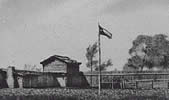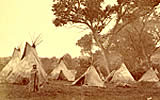1836-1844
1836
 Texans
rebel against government of Mexico; revolution ends at Battle of San Jacinto.
Texans
rebel against government of Mexico; revolution ends at Battle of San Jacinto.
Sam Houston becomes first president of Republic of Texas.
Republic of Texas constructs Forts Little River, Houston,
and Colorado to protect the northern and western frontiers of white settlement.
A large force of Indians, mostly Comanches, attack a private fort built by Silas and James Parker near the upper Navasota River. Silas and two women are killed, his daughter Cynthia Ann (9), son John (6), Mrs. Elizabeth Kellogg, Mrs. Rachel Plummer and her son James are carried away.
1839
 Mirabeau
B. Lamar, second president of the Republic of Texas, convinces Texas Congress
to move capital from Houston to Austin, near what is then the northwestern
frontier of white settlement.
Mirabeau
B. Lamar, second president of the Republic of Texas, convinces Texas Congress
to move capital from Houston to Austin, near what is then the northwestern
frontier of white settlement.
Lamar sends a large force to evict Cherokee and Kickapoo villagers from Texas. Cherokee Chief Bowl (Duwali) is killed in the ensuring battle near the upper Neches River. As a group of Cherokees tries to reach Mexico, a battle near the San Saba River ends the effort and the Cherokee War in Texas.
A force of rangers under John H. Moore, and Lipan allies under Chief Castro, attack a Comanche camp near the San Saba river, but loses its horses and is forced to retreat.
A battle near the present-day city of Temple between a ranger force under Capt. John Bird and a group of Indians results in the deaths of Bird and a Comanche chief.
1840
A negotiation with Comanche chiefs in San Antonio results in the battle known as the "Council House Fight."
In retaliation for the deaths of most of their chiefs in San Antonio, hundreds of Comanches sweep through central Texas, attacking Victoria and Linnville, on the Gulf Coast.
 Indians
returning from the raid on Victoria and Linnville are intercepted by a
force of rangers and militia at Plum Creek and suffer severe losses.
Indians
returning from the raid on Victoria and Linnville are intercepted by a
force of rangers and militia at Plum Creek and suffer severe losses.
Moore leads a punitive expedition of rangers and Lipans against a Comanche camp on the upper Colorado River. An estimated 125 men, women, and children are killed and 500 horses captured.
1841
 A
policy of offering land for colonization is adopted, ultimately resulting
in The Peters Colony contract (north Texas), Castro Colony contract (west
and south of San Antonio) and Fisher-Miller Grant (hill country).
A
policy of offering land for colonization is adopted, ultimately resulting
in The Peters Colony contract (north Texas), Castro Colony contract (west
and south of San Antonio) and Fisher-Miller Grant (hill country).
A large militia force attacks a group of Indian villages on Village Creek near the upper Trinity River. The Indians, estimated at more than 1,000, subsequently abandon the area. Fort Bird is established nearby as the most northwesterly white outpost on the frontier. The subsequent town of Birdville serves as the Tarrant County seat from 1849 to 1856.
1842
 Sam
Houston, elected to a second term as president, orders government moved
temporarily from Austin to Houston to reduce vulnerability to Mexican
army.
Sam
Houston, elected to a second term as president, orders government moved
temporarily from Austin to Houston to reduce vulnerability to Mexican
army.
Mexican forces under Generals Rafael Vasquez and Adrian Woll retaliate for Texan expedition to Santa Fe by invading Texas and occupying San Antonio.
1844
A series of negotiations, known as the Tehuacana Creek Councils, results in treaties of commerce with numerous Indian bands, including southern Comanches. The trade relationships help reduce frontier warfare for a short period.
 John Coffee Hays' 14-man ranger company attacks a Comanche
raiding party under Yellow Wolf near the Guadalupe River. Yellow Wolf,
a number of other Indians, and one ranger are killed. The battle is fought
on horseback and is believed to be the first such matching the rangers'
Colt revolvers against Comanche lances.
John Coffee Hays' 14-man ranger company attacks a Comanche
raiding party under Yellow Wolf near the Guadalupe River. Yellow Wolf,
a number of other Indians, and one ranger are killed. The battle is fought
on horseback and is believed to be the first such matching the rangers'
Colt revolvers against Comanche lances.
